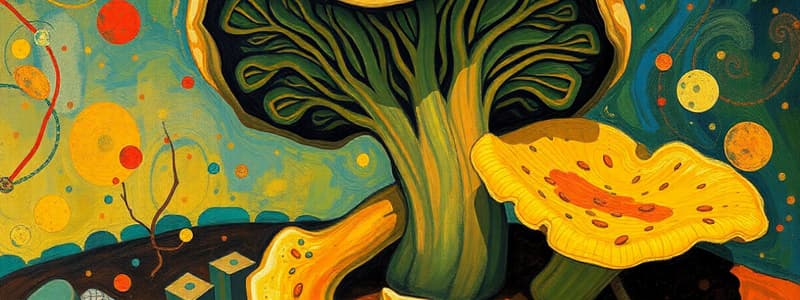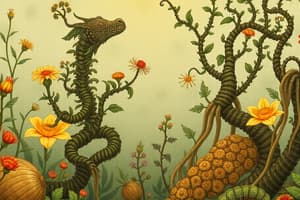Podcast
Questions and Answers
What is the primary role of a decomposer in an ecosystem?
What is the primary role of a decomposer in an ecosystem?
- To break down dead organisms and recycle nutrients (correct)
- To hunt and consume living animals
- To produce energy from sunlight
- To create shelter for other organisms
Which of the following is an example of a decomposer?
Which of the following is an example of a decomposer?
- A rabbit
- A sunflower
- A lion
- A mushroom (correct)
Yeast, used in making bread, is what type of decomposer?
Yeast, used in making bread, is what type of decomposer?
- Worm
- Fungi (correct)
- Insect
- Bacteria
Which factor does NOT affect the rate of decomposition?
Which factor does NOT affect the rate of decomposition?
Organisms that obtain energy by eating other organisms are known as:
Organisms that obtain energy by eating other organisms are known as:
An earthworm is an example of a:
An earthworm is an example of a:
Which of these locations is LEAST likely to have a high rate of decomposition?
Which of these locations is LEAST likely to have a high rate of decomposition?
In the decomposition process, what is 'fragmentation'?
In the decomposition process, what is 'fragmentation'?
What is the dark, nutrient-rich soil produced during humification called?
What is the dark, nutrient-rich soil produced during humification called?
Which of the following is a type of insect decomposer?
Which of the following is a type of insect decomposer?
Flashcards
Decomposer
Decomposer
An organism that breaks down decaying material, recycling nutrients back into the environment, ranging from bacteria to fungi.
Decomposition Rate
Decomposition Rate
The rate at which organic material is broken down by decomposers, influenced by temperature, oxygen, and water availability.
Heterotrophs
Heterotrophs
Organisms that depend on eating other organisms for energy.
Soil Bacteria
Soil Bacteria
Signup and view all the flashcards
Earthworms
Earthworms
Signup and view all the flashcards
Fungi
Fungi
Signup and view all the flashcards
Saprophages
Saprophages
Signup and view all the flashcards
Fragmentation
Fragmentation
Signup and view all the flashcards
Leaching
Leaching
Signup and view all the flashcards
Humification
Humification
Signup and view all the flashcards
Study Notes
- A decomposer is any organism that breaks down or consumes decaying material.
- Decomposers range from single-celled soil bacteria to multicellular fungi.
Importance of Decomposers
- Decomposers recycle materials from dead plants and animals back into the earth.
- They help keep habitats clean and aid in the production of foods using yeast.
- Yeast is a single-celled fungus that breaks down organic material and is crucial for making bread.
Factors Affecting Decomposition Rate
- Temperature, oxygen, and water influence the rate of decomposition.
- Warm temperatures with ample oxygen and water maximize decomposition.
- Cold temperatures with limited oxygen and water inhibit decomposition.
- Decomposition occurs more often in warm climates like Mexico and Hawaii than in polar regions like Alaska or northern Russia.
Decomposers as Heterotrophs
- Decomposers are heterotrophs, meaning they depend on other organisms for energy.
- Unlike humans and animals, decomposers consume decaying organisms.
Decomposers vs. Detritivores and Scavengers
- Scavengers eat dead animals and plants on a larger scale, aiding the decomposition process, with vultures as an example.
- Detritivores are decomposers that consume dead matter to break it down further, with worms as an example.
Examples of Decomposers
Bacteria
- Soil bacteria live in various environments, including lumps on plant roots.
- They chemically break down organic material in the early stages of decomposition.
- Common soil bacteria include Bacillus subtilis and Pseudomonas fluorescens.
- Billions of bacteria can be found in one gram of soil.
Earthworms
- Earthworms are invertebrates that ingest dead organic material and mechanically break it down.
- The scientific name for an earthworm is Lumbricus Terrestris.
- Earthworm castings contain valuable nutrients like nitrogen and phosphorus.
Fungi
- Fungi produce spores and live off organic material.
- They chemically break down organic material by releasing enzymes and digesting it into smaller pieces.
- Fungi release nitrogen and phosphorus back into the soil, which are essential for plant growth.
- Common fungi include mushrooms, molds, and yeast, from the subkingdom Dikarya.
Insects
- Insects are small invertebrates with segmented bodies, legs, antennae, and sometimes wings.
- Saprophages are insects that break down decaying organic material.
- Examples of saprophages include carrion beetles, blowflies, and dung beetles.
Decomposers in Various Ecosystems
- Oceans: Bacteria, fungi, tube worms, echinoderms, crustaceans, and mollusks
- Freshwater: Mildew, yeast, water mold, and trumpet snails
- Deserts: Dung beetles, flies, Saharan silver ants, and millipedes
- Grasslands: Turkey tail mushrooms, termites, and acidobacteria
- Mountains and Forests: Millipedes, mushrooms, beetles, pillbugs, slugs, snails, bolete mushrooms, purple fairy fingers, and mountain pine bark beetles
Decomposers in the Food Chain
- The food chain is a series of organisms where one depends on another for energy.
- Producers, like plants, make their own energy from the environment.
- Consumers ingest other organisms for energy, including herbivores and carnivores.
- Decomposers break down dead organisms and recycle nutrients back into the Earth, which producers use to make their own energy.
How Decomposition Works
- Fragmentation: Dead organic matter is physically broken down into smaller pieces by organisms like beetles and worms.
- Leaching: Water-soluble nutrients leave the dead organic matter and return to the surrounding soil.
- Catabolism: Bacteria and fungi release chemicals that break down organic matter into even smaller pieces, extracting inorganic nutrients.
- Humification: Humus, a dark soil containing various nutrients, is produced as bacteria, fungi, worms, and insects digest organic matter.
- Mineralization: Humus decomposes further, releasing inorganic nutrients like nitrogen and phosphorus into the soil with the help of soil bacteria.
Importance of Studying Decomposition
- Understanding decomposition helps scientists create biodegradable plastics, which can be broken down into simple compounds or molecules that the environment can use.
- Many biodegradable plastics break down in a few weeks to months.
Studying That Suits You
Use AI to generate personalized quizzes and flashcards to suit your learning preferences.



